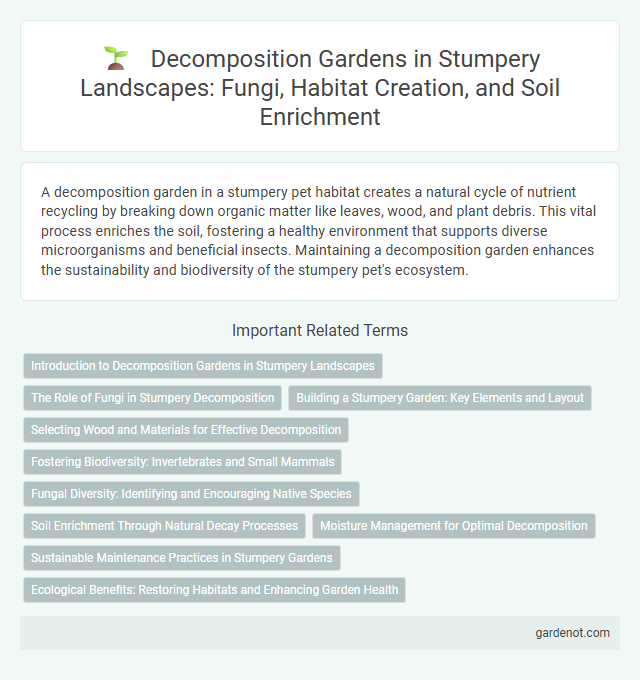A decomposition garden in a stumpery pet habitat creates a natural cycle of nutrient recycling by breaking down organic matter like leaves, wood, and plant debris. This vital process enriches the soil, fostering a healthy environment that supports diverse microorganisms and beneficial insects. Maintaining a decomposition garden enhances the sustainability and biodiversity of the stumpery pet's ecosystem.
Introduction to Decomposition Gardens in Stumpery Landscapes
Decomposition gardens in stumpery landscapes cultivate natural decay processes by integrating fallen wood, leaf litter, and organic matter to foster rich biodiversity and soil health. These gardens accelerate nutrient cycling, creating microhabitats for fungi, insects, and microorganisms essential to forest ecosystems. Incorporating decomposition gardens enhances ecological balance while showcasing the intricate beauty of natural decomposition within stumpery designs.
The Role of Fungi in Stumpery Decomposition
Fungi play a crucial role in stumpery decomposition by breaking down tough lignin and cellulose in tree stumps and dead wood, facilitating nutrient recycling in the ecosystem. The diverse fungal communities in these moist, shaded environments accelerate organic matter decay, enriching soil fertility and supporting plant growth. Mycorrhizal fungi also form symbiotic relationships with nearby plants, enhancing water and nutrient uptake while maintaining the health of the stumpery ecosystem.
Building a Stumpery Garden: Key Elements and Layout
Building a stumpery garden involves integrating decomposing wood, rocks, and shade-loving plants like ferns, mosses, and hostas to create a naturalistic habitat that supports wildlife and fungi. Key elements include arranging large tree stumps and logs in varied heights and orientations to craft textured layers, while ensuring proper drainage and moisture retention for optimal decomposition. The layout should balance organic shapes with pathways for accessibility, fostering an enchanting ecosystem that thrives on decay and organic recycling.
Selecting Wood and Materials for Effective Decomposition
Choosing hardwoods like oak or chestnut for a stumpery promotes slow, steady decomposition, providing long-lasting habitats for fungi and invertebrates. Avoid treated or resinous woods, as chemicals hinder microbial activity and soil health. Incorporate a mix of wood sizes and stages of decay to enhance biodiversity and ensure effective decomposition in the garden ecosystem.
Fostering Biodiversity: Invertebrates and Small Mammals
A decomposition garden fosters biodiversity by creating a habitat rich in decaying wood, leaves, and organic matter that attracts invertebrates such as beetles, worms, and fungi. These decomposers play a crucial role in nutrient cycling and soil health, supporting small mammals like shrews and hedgehogs that feed on them. This microhabitat encourages a balanced ecosystem essential for garden resilience and wildlife conservation.
Fungal Diversity: Identifying and Encouraging Native Species
A decomposition garden thrives by fostering fungal diversity, which plays a crucial role in breaking down organic matter and enriching soil nutrients. Identifying native fungal species such as oyster mushrooms (Pleurotus ostreatus) and turkey tail (Trametes versicolor) encourages ecological balance and supports local biodiversity. Promoting these fungi in stumperies enhances decomposition processes, creating a sustainable habitat for both plants and microorganisms.
Soil Enrichment Through Natural Decay Processes
A stumpery within a decomposition garden accelerates soil enrichment by harnessing natural decay processes of wood and organic matter. As fungi, bacteria, and invertebrates break down the stumps and plant debris, essential nutrients like nitrogen, phosphorus, and potassium are released into the soil. This biodiverse environment enhances soil structure, promotes microbial activity, and supports robust plant growth through sustained nutrient cycling.
Moisture Management for Optimal Decomposition
Moisture management is crucial in a decomposition garden to accelerate organic matter breakdown and maintain microbial activity. Ideal dampness supports fungi, bacteria, and invertebrates that drive decomposition while preventing waterlogging, which can cause anaerobic conditions and slow the process. Implementing mulch layers and ensuring proper drainage optimizes moisture levels, promoting efficient nutrient recycling within a stumpery ecosystem.
Sustainable Maintenance Practices in Stumpery Gardens
Sustainable maintenance practices in stumpery gardens emphasize natural decomposition processes and biodiversity support through mulch layering and minimal soil disturbance. Incorporating native fungi and decomposer organisms accelerates organic matter breakdown, enriching soil fertility without chemical inputs. Water conservation techniques such as drip irrigation combined with periodic pruning of decayed wood help maintain structural integrity and ecological balance in the stumpery ecosystem.
Ecological Benefits: Restoring Habitats and Enhancing Garden Health
A decomposition garden, often centered around a stumpery, accelerates the breakdown of organic matter, enriching soil fertility and supporting diverse microbial populations essential for plant health. This habitat restoration creates microenvironments for insects, fungi, and other organisms, promoting biodiversity and ecological balance within the garden ecosystem. Enhanced nutrient cycling and improved soil structure resulting from decomposition processes lead to more resilient and vibrant garden landscapes.
Decomposition garden Infographic

 gardenot.com
gardenot.com